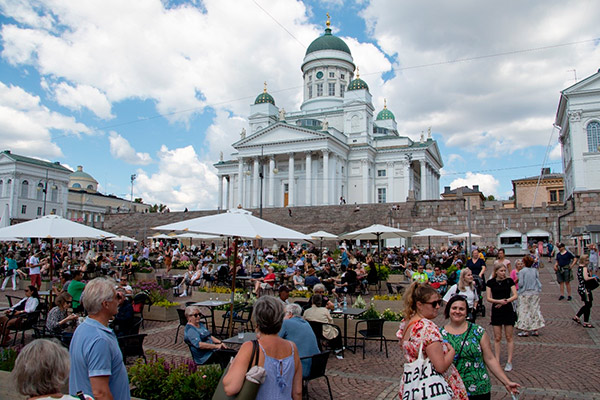The project to turn an iconic Helsinki landmark into a trendy and socially distanced food-and-drink mecca came together in just six weeks last summer, reviving domestic tourism and helping some businesses in the flailing restaurant sector to recover.
The City of Helsinki mobilised quickly in the coronavirus-tainted summer of 2020 to erect an ad hoc open-air food court in the historic heart of Finland’s capital. The successful experiment became a shining example of the kind of flexible out-of-the-box thinking required by public authorities in their efforts to revive stalled economies and adjust to a new normal.
Helsinki Mayor Jan Vapaavuori heralded the trial as an example of new ways to use urban spaces.
Head of the Senate Square project
Peggy Bauer reports that the food court created 250 jobs, kept dozens of hospitality and retail business in the downtown area afloat, and brought joy to over 400,000 domestic tourists.
“Everyone in Finland was so ready to take advantage of this new opportunity, after being stuck at home for so long. There was a collective craving for human interaction. Although the customers couldn’t be in close contact, at least they could see each other and share the same space. Many, many domestic tourists fell in love with Helsinki’s downtown area again, and this was our ultimate goal,” Bauer says.
Nimble teamwork made it happen
The city selected 16 restaurants and four pop-up outlets to sell their wares in the food court, and safe seating for 480 customers was eventually expanded to 830 to meet demand. On many sunny days, the tables in Helsinki’s new must-see venue were filled to capacity.
A municipal process that would normally take six months due to permits and planning was sped up to six weeks, which fell neatly in line with Helsinki’s strategic goal to cut permit application times and be a platform for innovation. The 200-year-old cobblestone Senate Square had no infrastructure, so the organising team had to scramble to supply the vendors and customers with water, electricity, toilets and handwashing stations.
“I’ve never seen people come together so quickly to make something happen. Everyone at the City of Helsinki seemed to be driven by an awareness that an idea like this could really make the difference for many downtown businesses and revive interest in the city,” Bauer says.
The successful concept also complied with the city’s ecological objectives. No plastic glasses or non-recyclable dishware were allowed in the space, and when the food court ended for the season, decorative flowerbeds were sold at a low price to residents for replanting. The stalls that housed the vendors were on loan from the annual Christmas Market.
Seeing our cities with new eyes
All in all, the Senate Square experiment holds many lessons for cities that are looking to recover from the coronavirus crisis. Decision-makers must be willing to streamline processes and use public spaces in new ways in order to come up with fresh community-building ideas. Bauer says our worlds have grown smaller now, so the role of our hometowns has also grown in importance.
“We need to make beautiful places for people to come together, now that they’ve got the time and interest to do so. The last few months have been rough for all of us and so it is on cities around the world to arrange events that can bring joy and allow us to see our home cities with new eyes,” she says.
Read more:
- Summer at the Senate Square: 400,000 visitors, 250 jobs, more than 2,000 Instagram posts
- Torikorttelit – a neoclassical part of the city
Photo credit: Paavo Jantunen.

